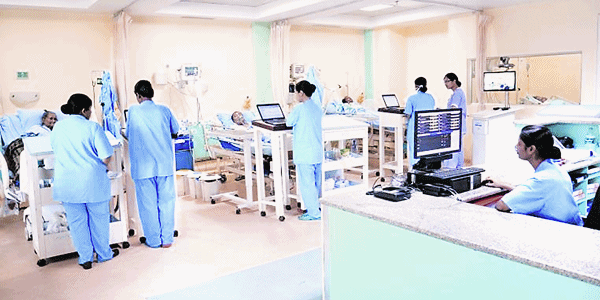How can technology assist intensivists to reach more patients through eICU? An analysis. By M Neelam Kachhap
Transcending past shortage of doctors, eICUs are making their presence felt in India. The first eICU was deployed in India about four years back. Since then this new technology has had a slow but steady growth, with early adopters in North and South Indian cities. With the benefits stacking up for it, eICU will not take long to penetrate the far ends of India even the neighbouring countries.
Almost all hospitals be it private or public has intensive care unit (ICUs). If you look closely these 10-20 beds which are separate section at any hospital are always full. For many, ICUs seems like a place that admits patients of poly-trauma (accidents) mostly, but given the rising incidents of new age infections diseases like dengue, Chikungunya, swine flu and Zika coupled with rising burden of geriatric population, ICU are in demand more than ever.

“In India five million patients require ICU care but only 70,000 ICU beds are available,” says Dr Amit Varma, Executive Director, CritiNext, Fortis Escorts Heart Institute (FEHI), Delhi. Outlining the need for more ICU beds as he points out that changing demographics that yield a higher proportion of geriatric individuals in the overall population will further increase the burden on supply side infrastructure.
Putting the shortage of ICUs into perspective, Dr RK Mani, CEO-Medical Services, Chairman Pulmonology & Critical Care Medicine, Nayati Healthcare, Mathura says, “There is no formal survey data available. But if we consider data from the vendors who supply ventilators to ICUs, we see that we have no more than 320 centres and 30,000 registered ICU beds against a requirement projected to be 1.2 million for the population.” And it seems like eICUs are the only visible solution for this growing critical care crisis.

Lack of trained manpower is another crisis, the critical care is facing in India. ICUs admit critically ill patients with a wide range of life threatening ailments. This needs special expertise primarily observation and prompt action which is provided by skilled doctors, nurses and specialised machinery. Like the rest of healthcare delivery, ICUs also struggle with huge manpower demand supply gap.
At first sight, ICU and intensivists seem to be in short supply in India. But the fact is that the medical education system did not upgrade courses to train enough doctors to be intensivists until a few years back.

“Intensive care is an emerging super speciality in India although in the developed world it has been so since the 1980’s. MCI has recognised it as a super speciality in 2009. Until then, there were no postgraduate courses offered by the government. The only training courses (IDCCM, FICCM) available until then were run by the professional bodies such as the Indian Society of Critical Care Medicine (ISCCM),” informs Dr Mani.
Even then the number of trained intensivists is nowhere near the required figure. “There is a requirement of about 50,000 trained intensivists in the country while there may be only about 8500 trained intensivists and every one of them in a metro city,” laments Dr Arindam Kar, Director, Medica Institute of Critical Care, Medica Superspecialty Hospitals, Kolkata.

So, how does eICU solve this problem? With the help of specialised software, cameras, microphones, and high-speed computer data lines, intensivists connect to patients virtually. “eICU is a technology-enabled remote critical care monitoring solution and is based on Hub and spoke model. The Hub being a technology-enabled centre, where clinicians are available 24/7 to monitor the remote locations. Hub provides round the clock clinical decision support in the form of clinical assistance and real-time monitoring of vitals, ventilators, labs and all critical care information about the patient,” explains S Shankar, Senior Director and Business Head, Patient Care and Monitoring Solutions, Philips Healthcare.

“eICU provides 24×7 coverage and remote monitoring assistance to bed side team and is great value to hospitals providing secondary level and tertiary level care in urban, semi urban and rural areas,” says Dr N Ramakrishnan, Senior Consultant & Director, Nithra Institute of Sleep Sciences, Chennai.
Indeed round the clock monitoring is of vital importance to critical ill patients and gives confidence to doctors in remote locations who struggle to save lives. “Through this system, we can provide patient data with vital waveforms, alarms, smart alerts and two-way video communication, all in real time, ensuring that a super specialist sitting in a command centre at a major metro city can view, interact, assess and treat patients in distant remote ICUs with full confidence and on a 24X7 basis,” explains Kar.
Talking about the set-up at Fortis Escorts Heart Institute, Delhi, Varma says, “Today at Critinext eICU, we manage over 350 ICU beds in 10 different cities in India with one site in Bangladesh.”
In Chennai the eICU has been functional since 2013. “InteleICU has been in operation from June 2013 and has covered more than seven hospitals across South India monitoring 30 odd ICU beds. More than 5,000 odd ICU patients have benefited from the InteleICU solution to-date.”
The eICU in Kolkata is being deployed in a phased manner. “The state-of-the-art e-ICU set up at Medica Super Specialty Hospital was initiated in the year 2014 and was implemented phase wise in the critical care units of the hospital,” shares Dr Kar.
“As part of the preliminary phase, the three medical ICUs and one neuro ICU of the central surveillance unit in Kolkata were inter-connected with each other. In the second phase, connection was established with the ICU of our partner hospital at Ranchi. In continuation to this venture, further expansion to our group hospitals at Siliguri, Jamshedpur, Ranchi, Gopalpur and Kalinganagar have already been formulated. In the third phase, plan is to rope in ICUs of government hospitals, following a PPP model,” he adds.
Apart from the obvious bridging of distance benefit, eICus have solved the problem of scarcity of resources. “This facility (eICU) will soon be available to us. From my previous experience on a smaller scale, patients and caregiver teams on site will greatly benefit from expertise available from a distant site as intensive care is a highly demanding and scarcely available resource,” says Dr Mani.
Talking about the benefits of eICU, Dr Ramakrishnan says, “The TeleICU solution is a complete solution to remote monitoring and managing critical care bringing forth world class protocols and best practices and secured and real time monitoring with high quality medical assistance by trained/ specialist critical care team monitoring patients with an ‘Extra Pair of Eyes.’ It can be customised for hospitals especially in remote areas where qualified intensivists are not readily available.”
Benefits of eICU
- Increased access and affordability of healthcare
- Access to broader range of specialists to patients around the clock
- Reduction of costs of healthcare because of technology
- Reduction of patient and relatives’ travel costs
- Better clinical outcomes
- Improvement in care parameters like ALOS, patient morbidity, mortality
- Improvement in organisation’s brand preference, quality and safety
- Higher patient satisfaction scores
- A platform for expansion into other areas of care
- Emergency life-saving care in ambulances
- Expansion into neonatal/ perinatal care for addressing the high infant mortality
Besides, eICUs are clinically-proven programme to improve quality and to reduce severity-adjusted mortality rates. According to a study published in 2004 in Critical Care Medicine, use of telemedicine can dramatically reduce hospital mortality rates for ICU patients by 27 per cent and ICU length of stay by 17 per cent, while also providing significant cost savings. In addition, job satisfaction and retention rates have been shown to increase among hospital nurses working with an e-ICU.
“ICU care delivered by super specialised intensivist led team provides distinct advantages to the patients– the mortality and complication rates are low and duration of ICU stay and overall costs of ICU care are less. The continuous monitoring of ICU patients help intensivist pre-determine possible complications and thereby limit any additional damage to patients,” shares Dr Kar.
Clearly there is a huge opportunity do deliver specialist-led ICU care to patients who are miles away from a specialist—a revolution that has been made possible because of the advancement of technology. So how much does this technology cost? “For full online data acquisition for ICU patients including ventilator, monitor and infusions the investment for 25 beds would be approximately a crore,” estimates Dr Mani.
Concerns with eICU
- High cost of technology
- Lack of cooperation between on site physicians and eICU specialists
- ‘Big Brother’ concerns, particularly among young physicians with limited experience
- Staff turnover at remote sites
- Limits access to patients in ICU
- A breakdown in the relationship between health professional and patient
- Different knowledge and skills required of health professionals and ergonomic issues
- Issues concerning the quality of health information
- Organisational and bureaucratic difficulties.
- Depersonalisation
- Physical and mental factors
- Lack of confidence of patients and health professional
- Capex investments by spoke hospitals, specifically camera
- Monthly collections
- Connectivity/ bandwidth reliability
- Push back by regional clinicians
- Lack of medical equipment infrastructure
- Usage of eICU decreases over time
- Price per day per bed
Providing another perspective Dr Ramakrishnan says, “A total investment of less than Rs 3 lakhs excluding the bedside digital patient monitors is the investment needed to connect a remote rural five-bedded ICU to a monitoring centre.”
Infact, once deployed there is no limit to the size of ICU connected to the technology. “The Intellispace Consultative Critical Care (ICCC) can cover all the ICU’s (adult to neonate). The size is limitless because you just need an Internet connection to connect the remote locations,” shares Shankar. Talking about the benefits of technology, Dr Verma says, “A 1000-ICU beds can be manned by only 20 intensivists.”
Indeed, eICUs have proven to be an indispensable tool to monitor and treat critical patients but does the technology have any limitations? One of the major concerns for this technology is penetration of Internet services. “You need an Internet connection to connect the remote locations. The limitations would be non – availability or insufficient Internet solutions at smaller towns,” explains Shankar. Besides the availability of trained staff is a must for the success of eICU. “If there are lack off backup trained staff at the bed side, the TeleICU monitoring will not be effective and not be able to deliver the required results,” shares Dr Ramakrishnan.
In addition there is a fear of technology the insecurity of ‘Big Brother’ watching. “eICU is relatively new. Many bedside doctors and nurses do not understand how the system works. They believe that the nurses and intensivists at the eICU command centre are watching them and trying to take over. In reality, the purpose of the system is to provide improved safety through redundancy and enhance outcomes through standardisation. The eICU team has a supportive role. They have an overview of all the patients in the unit and can alert the bedside staff if any problems occur,” elaborates Dr Varma. eICU is not a a way to enforce totalitarian regime and ensuring conformity but a means to enable care by building relationships.
Sometimes its the inert fear of adopting new technology that results in lack of cooperation between on site physicians and eICU specialists. “Another barrier to ICU telemedicine is the clinician’s acceptance of the technology. Few clinicians feel that everything is running perfectly and nothing needs to be fixed. Showing these physicians comparative data and the benefits of eICU may change their mind,” opines Dr Varma.
Adding to this, Dr Mani says, “There must be excellent on site ICU team who can receive strategic guidance from an expert and implement with discretion. It cannot be effective if adequate staffing and competencies are not available on the ground.”
Intraoperability is also a concern here as various devices need to communicate with the eICU software. “The lack of integration was a problem at some hospitals, especially those that did not have eICU software compatible medical equipment e.g. monitors ventilators & ABG machine etc.” says Dr Varma.
Even though the benefits and limitations are understood by clinicians, there is still the matter of return-on-investments. “The non-adapters think that only cost is the concern but there are huge benefits clinically and financially by using eICUs. In the long run, the advantages and benefits are immense and this is also a clear differentiator for hospitals,” says Shankar.
The concept of telemedicine has been around for a long time. In fact, the World Health Organisation (WHO) has defined the opportunities and developments of telemedicine in member states. However, there is no legislation which deals with the practice of telemedicine or eICU in India. The practice of telemedicine in India is governed by those laws which govern a normal patient/ doctor relationship.
Dr Milind Antani, Partner Pharma & Healthcare Practice, Nishith Desai Associates stated in an interview that, ‘In India, generally, Section 304-A of the Indian Penal Code (IPC), 1860, is the relevant provision under which a complaint against a medical practitioner for alleged criminal medical negligence is registered. Section 304-A provides that whoever commits culpable homicide not amounting to murder shall be punished for life or imprisoned for a term up to 10 years and fined as well. Section 337 of the IPC deals with hurt caused by an act endangering the life or personal safety of others. However, the simple lack of care attracts only civil liability. Therefore, only civil negligence may not be enough to hold a medical professional criminally liable.’
There is, however, a guideline issued in May, 2003 by the Department of Information Technology, Ministry of Communications and Information Technology called Recommended Guidelines & Standards for Practice of Telemedicine in India.
The guidelines outlines the necessary information on telemedicine, including, definitions and concepts, standards required for hardware, software and clinical devices, including the security aspects and finally the telemedicine process guidelines.
However, these guidelines are not binding in Indian courts but it would be in the interest of the hospitals to follow them.
Future is bright for eICU technology in India, as the existing users are exploring new avenues of revenue streams using this technology. “We are tying up with ICUs of government hospitals, following a PPP model, with technological support of vendor and Critinext. Now, we are focusing on connecting ICUs in the North Eastern part of our country as well as neighbouring countries like Nepal, Bangladesh, Myanmar and other countries,” shares Dr Kar.
In South India, smart connected city initiatives will provide impetus to uptake this technology. “When connectivity improves and the smart cities are interlinked, wider coverage by Intensivists can be envisaged,” says Dr Ramakrishnan.
Mulling over the future of eICU, Dr Varma says, “Clearly, innovative measures are the order of the day to optimise efficiency of scarce critical care resources. EICU has the potential to focus on untapped opportunities, geographic locations and underserved segments in the developing world. The burgeoning Asian market offers a challenging opportunity for value creation. Other than clinical improvement, eICU also introduces paperless ICU culture by electronic medical record system and increased focus on ICU performance.”
Like telecommunication, eICu technology will also become cheaper as more vendors enter the market benefiting the patients. “The technology should get easier to set up and less expensive. Expertise can then be available even in remote areas,” thinks Dr Mani.
Summing it up, Dr Varma says “While it will never supplement on site staffing, however, a country which lacks basic medical staffing at general level, this will help to provide specialised care at bedside which would not have been possible at all.”





Comments are closed.